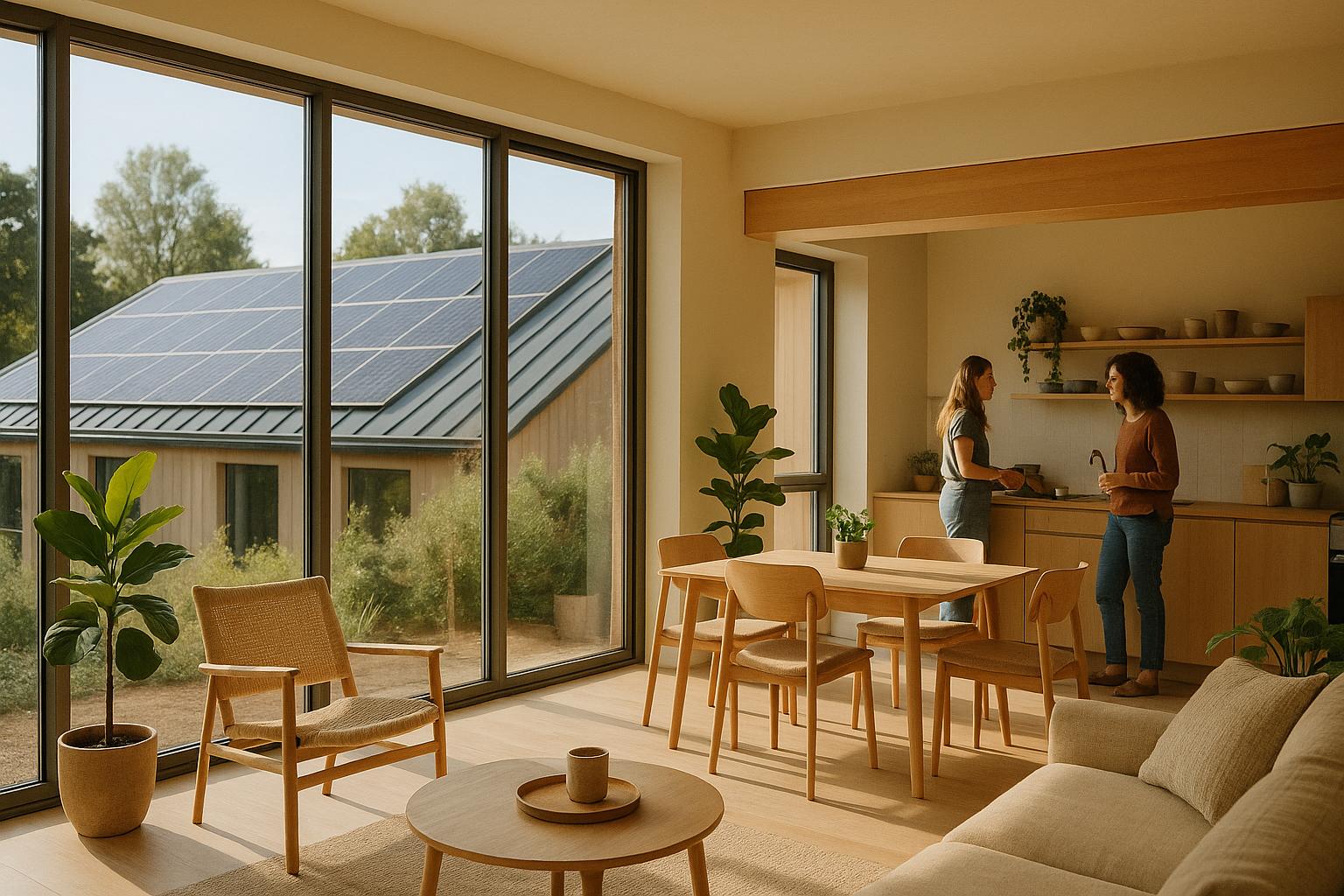Living in a coliving space offers a modern and hassle-free way to live, combining affordability, convenience, and community. Here's what makes coliving stand out:
- Lower Costs: All-inclusive pricing covers rent, utilities, Wi-Fi, and cleaning, simplifying budgeting and saving money.
- Built-In Community: Social events and shared spaces create opportunities for connections and support.
- Flexible Leases: Month-to-month options make moving easier without long-term commitments.
- Convenience: Fully furnished spaces and streamlined move-in processes save time and effort.
- Networking Opportunities: Casual interactions with professionals from various fields can lead to career growth.
- Eco-Friendly Living: Shared resources reduce waste and environmental impact.
- No Maintenance Hassles: On-site teams handle repairs and upkeep.
- Global Connections: Meet people from diverse backgrounds and expand your network worldwide.
- Safety: Smart security systems and a sense of community provide peace of mind.
- Shared Responsibilities: Organized chores and house rules create a stress-free living environment.
Coliving is especially appealing for digital nomads, remote workers, and young professionals looking for a simpler, more connected way to live. With access to thousands of spaces worldwide, platforms like Coliving.com make finding your next home easy.
1. Lower Costs and All-Inclusive Living
Coliving can be a game-changer when it comes to saving money. Instead of managing separate bills for rent, utilities, internet, and cleaning services, coliving wraps everything into a single, consistent monthly fee. This streamlined approach eliminates unexpected costs, making it easier to stay on top of your finances.
In bustling cities where studio apartments often come with hefty price tags, coliving provides a budget-friendly alternative. Most setups offer private rooms paired with shared common areas, and they often skip extra charges like security deposits or service fees. This simplicity not only reduces stress but also makes budgeting much more straightforward.
The fixed monthly payments are especially helpful for young professionals and remote workers. Knowing exactly how much you’ll spend each month allows you to plan ahead - whether that’s putting money toward travel, furthering your education, or building up your savings. Plus, the shared model makes premium perks more accessible. For example, instead of paying for a gym membership or coworking space on your own, you split the cost with other residents, giving you access to top-notch amenities at a fraction of the price.
Another advantage is the flexibility in lease terms. Many coliving arrangements offer short-term or month-to-month leases, giving you the freedom to adjust to changes in your life - whether it’s a new job or a personal decision - without worrying about steep penalties.
2. Ready-Made Community and Social Support
Coliving offers more than just a place to stay - it creates a built-in community. With regular events like communal dinners, movie nights, language exchanges, skill-sharing workshops, and group outings, residents are brought together in ways that foster connection and camaraderie. These shared experiences help form a supportive network, making it easy to feel at home right from the start. Beyond the financial and practical perks, this sense of belonging is a key part of what makes coliving so appealing.
3. Flexible Lease Terms and Easy Moves
Renting a traditional apartment often comes with a long list of headaches: 12-month lease commitments, hefty security deposits, and frustratingly complex move-in processes. Coliving spaces, however, flip the script. With month-to-month lease options and a smooth, hotel-like move-in experience, coliving makes relocating much easier and far less stressful. This flexibility not only reduces financial strain but also makes the entire moving process feel effortless.
One major perk? Coliving slashes upfront costs. Security deposits are much lower, and everything - utilities, Wi-Fi, and even cleaning services - is bundled into a single monthly payment. For example, in Los Angeles, coliving beds typically range from $1,100 to $1,600 per month, while renting a one-bedroom apartment averages over $1,700 before you even factor in utilities and other extras.
Moving in is a breeze. New residents get detailed email instructions, including access codes and step-by-step directions, and can easily coordinate flexible arrival times with their host or customer support. Need to arrive late? No problem - just message your host through the platform to arrange a time that works for you. This straightforward process reflects coliving's focus on ease and convenience.
Another huge advantage is that coliving eliminates the hassle of furnishing and setting up a new home. Everything you need - beds, desks, kitchen appliances, and even cleaning supplies - is already provided. All you have to do is show up with your suitcase, making it an ideal option for digital nomads, students, or professionals relocating for work. And when it’s time to move on, the process is just as simple. There’s no need to worry about selling furniture, disconnecting utilities, or deep-cleaning the space. With coliving, you can leave quickly and without the burden of breaking a lease or paying steep fees, allowing you to focus on your next opportunity.
4. Better Amenities for Work and Life Balance
Living in a traditional apartment often means juggling the setup of a workspace and hunting down leisure options on your own. Coliving spaces, however, take a different approach by blending work and relaxation into one seamless experience. They’re designed to support both productivity and personal well-being.
Beyond saving money and offering flexibility, coliving spaces simplify your daily life. Many provide on-site work areas equipped with high-speed internet and ergonomic seating, cutting out the need for separate coworking memberships. On top of that, they often include health and leisure facilities, so you can stay active and unwind without leaving home. Whether it’s a quick workout, lounging in a cozy common area, or mingling with fellow residents, everything is right at your fingertips.
What’s even better? All these amenities are included in your monthly rent. No need for extra memberships or surprise expenses - it’s an all-in-one solution that makes budgeting easier and helps you maintain a healthier work-life balance.
5. Professional Networking and Personal Growth
Coliving isn’t just about saving money or enjoying a comfortable lifestyle - it’s a springboard for career growth. These spaces naturally extend your professional network and provide opportunities that go well beyond the typical workday.
Rather than relying on formal networking events, coliving offers a more organic way to connect with like-minded professionals. Imagine sharing a meal or a coffee with remote workers, entrepreneurs, startup founders, and digital nomads. These casual conversations often lead to meaningful exchanges about shared challenges, like finding clients or launching new projects.
Living with professionals from diverse fields - whether they’re software developers, marketing experts, or creatives - creates unique opportunities for collaboration, mentorship, and referrals. These connections can spark ideas for joint projects that might never come up in traditional living situations. Plus, being surrounded by driven individuals can inspire personal growth, pushing you to reevaluate your goals and strive for more.
The environment also encourages learning and experimentation. Whether it’s picking up a new skill, exploring a different industry, or gaining the confidence to take a bold career leap, coliving fosters an atmosphere of curiosity and ambition.
Many coliving communities have a global mix of residents, adding another layer of professional enrichment. Exposure to international work practices helps you understand global markets and navigate opportunities outside your local sphere. This can be especially valuable if you’re considering expanding your freelance services globally, working remotely for international companies, or simply gaining insights into how your industry operates around the world.
What starts as a casual connection in a shared living space often evolves into lasting professional relationships. These partnerships can lead to ongoing collaborations, trusted referrals, and strong recommendations that support your career for years to come.
6. Eco-Friendly and Resource-Efficient Living
Coliving spaces bring a sustainable twist to urban living, offering a smarter way to reduce environmental impact while maintaining modern comforts. By sharing resources and maximizing space, these communities significantly lower the ecological footprint of each resident compared to traditional apartments.
For starters, coliving buildings can fit 113% more beds into the same residential floor area as standard apartments. This efficient use of space means fewer buildings are needed to house the same number of people, cutting down on new construction and helping to preserve urban land.
Shared amenities also play a big role in saving resources. Instead of every resident owning their own appliances - like washing machines, dryers, or vacuum cleaners - these items are shared among the community. This reduces the total number of manufactured goods required, lowering production demands and minimizing electronic waste when items eventually need replacing. On top of that, thoughtful building designs help reduce environmental impact even further.
Coliving developments deliver measurable carbon savings, with 10-20% less embodied carbon per building and 21-36% less per person compared to traditional housing. This means the carbon emissions tied to construction materials and processes are much lower for each resident.
Many coliving spaces also embrace smart technologies and eco-conscious construction methods. Features like LED lighting, energy-efficient HVAC systems, and sustainable materials are common. Some communities even go a step further with advanced waste management systems, composting programs, and collaborations with local groups to minimize food waste.
Living in a shared environment naturally promotes sustainable habits. Shared spaces often create a sense of accountability, encouraging residents to be mindful about things like turning off lights, conserving water, and reducing waste. This community-driven mindset makes it easier to adopt greener practices in everyday life.
And here's the best part: this focus on resource efficiency doesn’t come at the expense of comfort. Residents still enjoy access to high-quality amenities and modern living spaces - they’re just shared in a smarter, more thoughtful way with others who care about community and the planet.
7. No-Hassle Maintenance and Management
One of the standout perks of coliving spaces is the ease of maintenance and management. Dedicated teams take care of everything - from fixing a broken dishwasher to repairing a faulty air conditioner - so you don’t have to stress over unexpected repairs. Plus, since these services are included in your monthly fee, budgeting becomes much simpler. No more surprise bills throwing off your finances.
With on-site staff and community managers ready to address minor issues quickly, you’re free to focus on what matters most - whether that’s work, socializing, or pursuing your hobbies. This hands-on approach ensures the living space stays in excellent shape, with shared areas always clean and functional.
It’s a setup designed to make life easier, offering a seamless, worry-free living experience.
8. Cross-Cultural Exchange and Global Networking
Living in a coliving space offers a unique opportunity to form meaningful connections with people from all corners of the world. Imagine sharing a meal with a software engineer from Berlin, brainstorming startup ideas with an entrepreneur from São Paulo, or learning about sustainable living from someone raised in rural Japan. These interactions often grow into valuable personal and professional relationships.
Coliving spaces come with a built-in, international community. With properties spanning over 380 cities in 70 countries on Coliving.com, you'll encounter individuals from diverse backgrounds, industries, and cultures. This diversity brings constant exposure to new perspectives, business practices, and creative solutions to everyday challenges.
Conversations in these spaces often lead to unexpected insights, whether it's about European consumer trends or shifts in Asian markets. These connections don't just stay local - they expand globally. As residents travel for work or leisure, they often discover they've already built relationships in other cities through their coliving networks. This global web of contacts can be a game-changer for career growth, business opportunities, or simply having a friendly face in a new city.
Language exchange happens naturally, too. You might find yourself helping a French housemate polish their English while they teach you conversational French. It's a practical and affordable way to improve language skills while forming genuine friendships.
In today’s world, this global perspective is a powerful professional advantage. Employers increasingly value skills like cultural awareness, cross-language communication, and the ability to collaborate in diverse environments. Living in a coliving space allows you to practice these skills daily, giving you a noticeable edge in navigating international workspaces and building a career with a global outlook.
9. Safety and Security
Coliving spaces go beyond offering cost-efficient and flexible living - they prioritize safety and peace of mind. With 86% of young adults ranking personal safety as a top concern, these spaces are designed to provide a secure environment through a mix of advanced technology, thoughtful design, and community engagement.
Smart security systems play a big role in reducing risks. Features like smart locks, security codes, or mobile app access replace traditional keys, making unauthorized entry much harder. High-definition cameras monitor shared areas, entrances, and outdoor spaces around the clock, offering an added layer of protection. Unlike many traditional rentals, these safety measures come standard in coliving setups, with outdoor spaces and designated safe zones further enhancing security.
But technology is just one part of the equation. The sense of community in coliving spaces acts as a natural security net. When neighbors know and trust each other, they’re more likely to notice anything unusual and take action, whether that’s contacting property management or alerting local authorities. This informal watch system not only boosts safety but also helps reduce feelings of isolation, creating a supportive environment where residents feel cared for.
Property management adds another layer of protection through background checks, visitor policies, and responsive support teams. Regular cleaning and maintenance routines in shared spaces don’t just ensure hygiene - they also help identify potential safety issues early.
Fire safety is another priority. Coliving spaces are equipped with alarm systems, fire extinguishers, and clearly posted evacuation plans. Many even conduct safety drills and assign emergency response roles, ensuring everyone knows what to do in a crisis.
This comprehensive approach to safety allows residents to focus on what matters most - building connections and pursuing their goals - without the constant worry of security concerns hanging over them.
10. Shared Household Responsibilities
Sharing household responsibilities in coliving spaces isn't just about keeping things tidy - it's about fostering a sense of community and making daily life easier for everyone. Just like the streamlined move-in process and included amenities, dividing up chores creates a more harmonious and stress-free living experience. Tasks like cleaning kitchens, bathrooms, and common areas, managing trash, or even grocery shopping are often organized through rotation schedules. This not only keeps things fair but also helps residents build connections with one another.
Clear house rules play a key role in maintaining this balance. Many coliving spaces establish guidelines for cleaning schedules, respecting personal spaces, and outlining everyone's responsibilities. These rules help prevent misunderstandings and ensure that everyone knows their part in keeping the space running smoothly. Rotating tasks weekly or monthly ensures no one feels stuck with the same chore for too long.
"The 'Community through Coliving' approach comes with more purposeful commitments to creating a strong sense of connection between the members, and sharing more responsibilities and benefits." - Kat Vellos
But shared responsibilities in coliving go beyond just chores. Residents often collaborate on projects like maintaining a rooftop garden, organizing communal spaces, or planning group meals. These shared efforts create a sense of purpose and strengthen the bonds within the community.
To keep everything on track, many coliving spaces hold regular house meetings. These gatherings are a chance to discuss cleaning schedules, address concerns, and keep communication open. By tackling issues as a group, small problems are resolved before they grow into bigger ones.
The result? A cleaner, more organized home and a stronger sense of community. Instead of coming home to a messy kitchen that feels like your sole responsibility, you might find it already spotless thanks to a housemate's turn in the rotation.
Some coliving spaces even take it a step further by offering professional housekeeping for deep cleaning. This allows residents to focus on maintaining the space day-to-day and engaging with their community, rather than worrying about every little detail.
Comparison Table
Coliving spaces bring a package of services and flexibility that traditional rentals just don’t match. From bundled costs to a built-in sense of community, coliving reshapes how people approach modern living. Here’s a side-by-side look at how coliving stacks up against traditional rentals:
| Feature | Coliving Spaces | Traditional Rentals |
|---|---|---|
| Monthly Cost | All-inclusive pricing that covers rent, utilities, and amenities | Base rent with separate expenses for utilities and other services |
| Security Deposit | Minimal or sometimes not required | Typically requires a deposit equal to one or two months’ rent |
| Lease Flexibility | Month-to-month or short-term agreements | Usually requires a 12-month lease |
| Furnishings & Utilities | Fully furnished; utilities and cleaning services included | Often unfurnished, with additional costs for furniture and utility setup |
| Community & Services | Organized events, regular maintenance, and networking opportunities | No structured community or built-in services; tenants handle these on their own |
| Move-In Process | Quick and hassle-free with everything pre-arranged | Longer application process with added time for setup |
| Cancellation Policy | Flexible terms to accommodate changing needs | Strict policies, often with penalties for early termination |
This breakdown makes it clear: coliving doesn’t just simplify life - it offers a more convenient, community-focused way to live.
Conclusion
Coliving is reshaping the way we think about modern living, catering to the needs of today’s mobile professionals and community-oriented individuals. The benefits go beyond just shared spaces - coliving encourages personal growth, professional connections, and meaningful social interactions.
The all-inclusive pricing model eliminates hidden costs, making it an appealing option financially. Add in flexible lease terms, built-in communities, and access to high-end amenities, and it’s clear why coliving is such a practical choice. For digital nomads and young professionals who value experiences over material possessions, coliving offers both convenience and connection. The networking opportunities naturally embedded in these spaces can open doors to new friendships and career advancements.
Coliving spaces also foster cultural exchange and professional growth in a way that feels organic. The shared responsibilities and secure environments reduce everyday stress, allowing residents to focus on their goals - whether that’s advancing their careers, exploring new cities, or forming lasting bonds with like-minded people.
As traditional rental options remain rigid, coliving emerges as a flexible and community-driven alternative that aligns with modern values like connection and simplicity. For those looking for a living arrangement that complements their lifestyle rather than complicates it, Coliving.com offers access to over 2,000 coliving spaces in 400 cities across 70+ countries. Finding a home that prioritizes community and convenience has never been easier.
FAQs
How does coliving offer privacy while creating a sense of community?
Coliving spaces strike a balance between solitude and social interaction, offering the best of both worlds. Residents have private bedrooms or personal areas where they can relax and recharge. At the same time, shared spaces like kitchens and lounges provide opportunities to connect, collaborate, and build a sense of community.
To ensure everyone feels comfortable, these spaces often include features like secure entry systems, designated quiet zones, and clear rules for shared areas. This thoughtful setup allows individuals to enjoy their privacy while fostering meaningful relationships with others, creating a living environment that's both peaceful and engaging.
How does living in a coliving space help the environment compared to a traditional apartment?
Living in a coliving space offers a greener alternative to traditional apartments. By sharing resources such as appliances and utilities, coliving can cut energy use by as much as 30%, reduce water consumption by about 20%, and lower waste production by approximately 23%. Many of these spaces also feature eco-conscious designs and smart technologies, which further help to shrink their environmental footprint.
On top of that, coliving buildings are often constructed to reduce embodied carbon emissions by 10–20%, making them a step toward a more sustainable future. Opting for coliving not only aligns with a modern, community-focused lifestyle but also plays a role in minimizing your impact on the planet.
How can living in a coliving space help with building professional connections and advancing your career?
Coliving spaces are a natural breeding ground for professional connections and career advancement. By sharing a living environment with driven, like-minded individuals, residents find countless opportunities to interact, collaborate, and exchange ideas on a daily basis. These everyday connections often evolve into meaningful relationships that can inspire new projects, partnerships, or even open doors to career opportunities.
What makes coliving even more dynamic are the events, workshops, and networking activities many spaces organize. These gatherings make it easy to broaden your professional network while learning from people across a variety of industries and backgrounds. The sense of community built into coliving fosters a supportive environment where innovation thrives, and residents can help one another reach their career goals.






